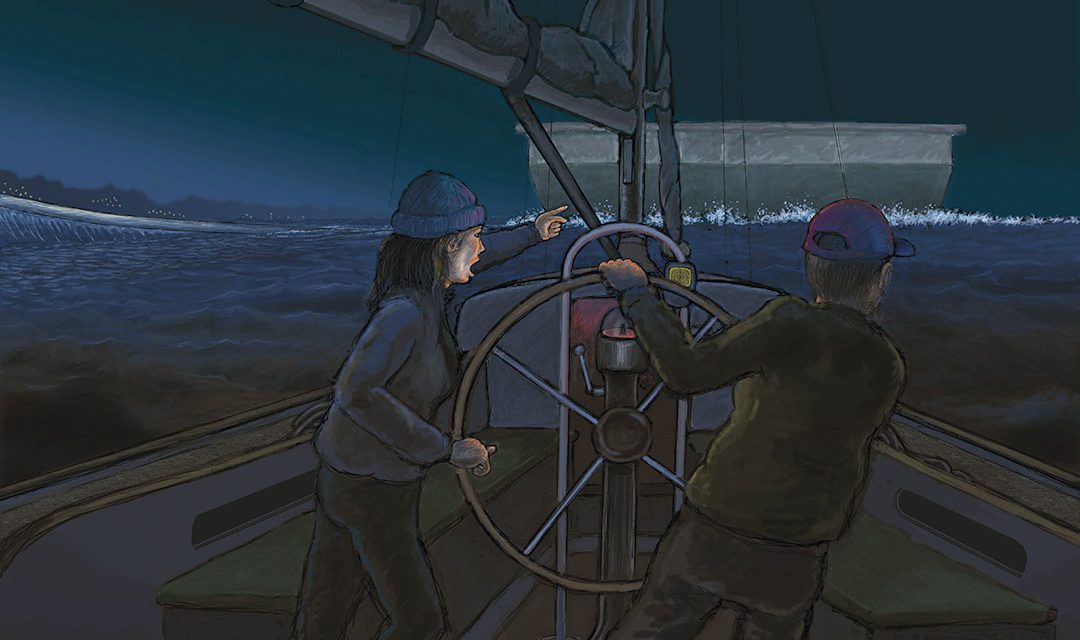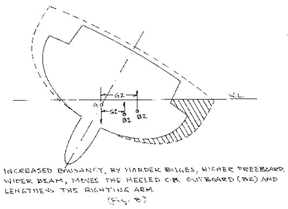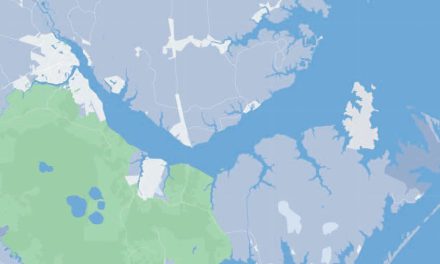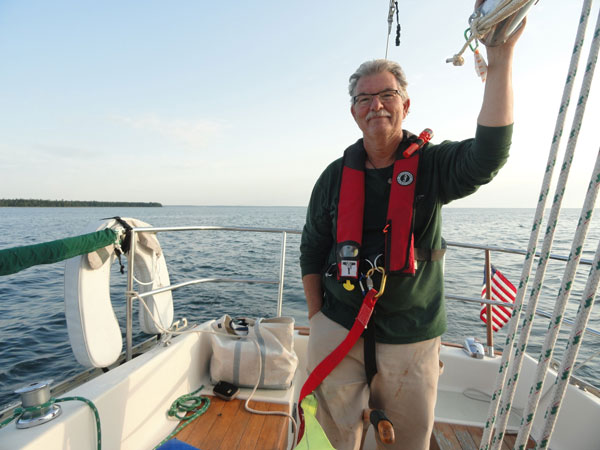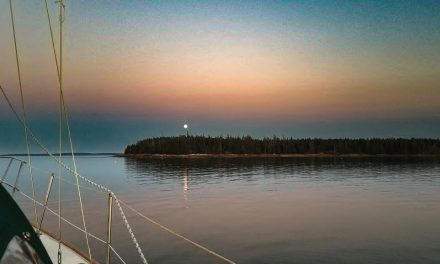A night passage in familiar waters nearly ends in disaster.
I’m not a great sailor, not even a very good one. But I enjoy moving from one place to another in that way, and I’ve long thought my seamanship knowledge and judgment are sufficient to get me, my crew, and boat wherever we’re going safely. Then I almost lost my boat and my family in a chain of events that spanned about five minutes.
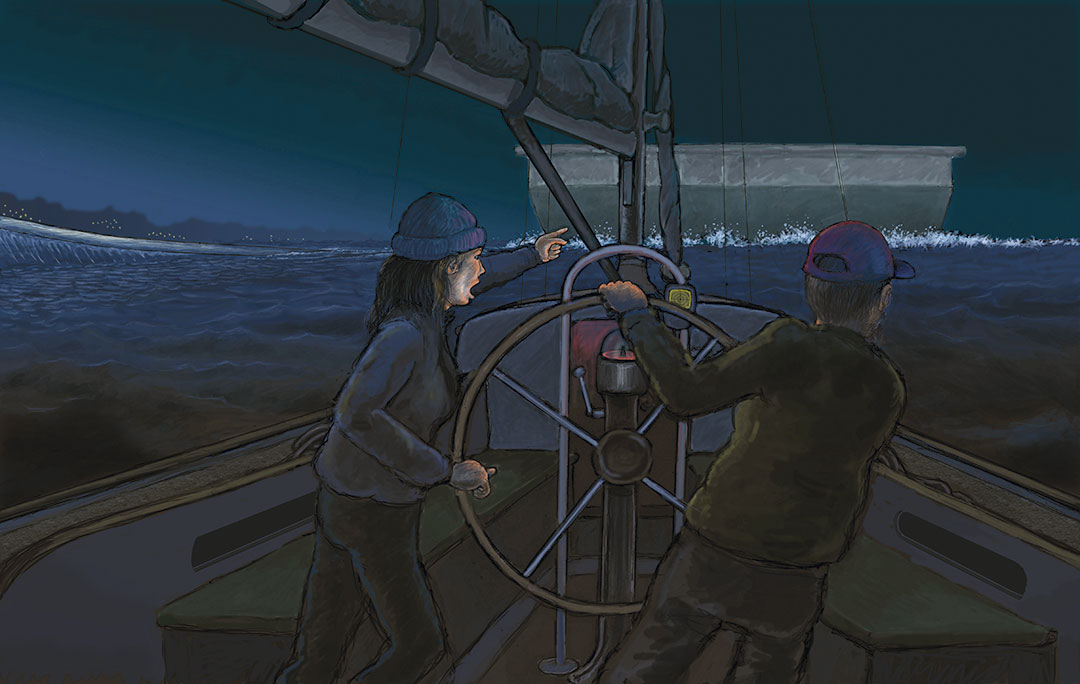
After almost a week in Astoria, Oregon, visiting family and friends and waiting out storms before heading south, it was time to go. We planned to sail direct to Eureka, California, a 350-nautical mile coastal passage through The Graveyard of the Pacific that would require we cross two notorious bars: the Columbia River Bar departing Astoria and the Humboldt Bay Bar arriving at Eureka. In each case, timing the tides was critical. As our trip would cover three nights and two days, we paid attention also to wind and sea-state forecasts for the stretch.
All day Thursday, we readied for an evening departure. As evening came, my wife, Windy, in charge of all navigation, routing, and general planning, took another look at everything and determined it might be better to hold off until morning. Leaving as planned, we risked arriving at Humboldt too late for the tide to allow us to cross the bar if our speed was even a bit less than projected. And arriving too late could mean having to wait outside for several hours.
“But if we make good speed, we can still leave tonight and make Humboldt on time?” I asked.
“Yes,” she hesitated, “if everything goes perfectly.”
I don’t like change. I bristled at the prospect of plan upheaval. We’d sent emails to everyone announcing our imminent departure. We’d just finished refueling and successfully arranged with the fuel dock to remain tied there for a few more hours until departure time.
“I say we go.”
And we did.
And you think you know where this is going, right? You think this is a story of calamity that stemmed from my impatient urging that we leave, despite my wife’s reasoned counsel.
Nope.
At 7:30 p.m., we left the fuel dock and motored out of the marina at the base of the Astoria-Megler Bridge. We had nearly two hours of narrow shipping channels to navigate through protected waters before we reached the bar and were free and clear in the dark Pacific Ocean. Windy went below to help our girls clean up after dinner and to secure things that needed to be stowed for the passage. I guided our 40-foot sloop from the cockpit.
“Call me if you need anything.”
“Yep.”
This would be our fourth transit of this channel and across the Columbia River Bar. Even in the dark, this is pretty boring stuff. I had all the channel-marking buoys, the channel, and our boat displayed as a blue dot on the screen of the iPad clamped to the bimini frame beside me. Most of the channel traffic was reflected on the tiny AIS screen of our remote VHF microphone on the binnacle. And the conditions were perfectly clear; I could see everything around me for miles, a sea of shoreside lights in the background and the lights of other vessel traffic and flashing channel markers all around. I was bundled up against the cold night on the water and our speed was about 5.5 knots under power.
For 45 minutes, I did little else besides make adjustments to the autopilot to keep us on our side of the 600-foot-wide channel. There was a cross current, and we repeatedly drifted off course. Going straight required we crab a bit. A couple of small fishing boats passed in the opposite direction, but there otherwise seemed to be little traffic. I looked for anticipated marker buoys ahead and I looked for unanticipated traffic from behind. I listened to big ships on the radio 15 miles out, each of them coordinating their bar pilot rendezvous.
The running lights of the next opposing traffic were about a half-mile away. I thought it might be a large fishing boat. There was no question in my mind we would pass port-to-port, as we should. “Red-to-red,” is how I’ve heard some of the commercial captains on the radio say it.
Recall I said that I almost lost my boat and my family in a chain of events that spanned about five minutes. At this point in the story we haven’t yet crossed the fear-inspiring Columbia River Bar, we haven’t entered The Graveyard of the Pacific, we haven’t even sailed night and day and night and day and night along a North Pacific coastline where gales this time of year are a dime a dozen and come out of nowhere, quickly—nor have we made it across the next bar and into Humboldt Bay. But none of those potential, perceived hazards are relevant; we can go ahead and start that five-minute clock right now, while things are as straightforward and boring as they can be.
There is about a half-mile between me and the oncoming vessel in this narrow shipping channel. Given our roughly 15-knot closure speed, we’ll pass each other in about two minutes.
It’s a very dark night. My depth perception is off and I’m trying to make out a shape. I make a million subliminal mental calculations as I watch this traffic, continuously trying to make sense of the lights all over the boat, of the lights on the hills and shoreline beyond it. But my interest is pretty subdued; I know it will all be clear as we get closer.
Then I realize we are a bit closer, closer than I assumed, less than a quarter mile now and getting brighter, but still not a concern. We’ll pass by, two proverbial ships in the night. I wonder if they see me—my little LED running lights so low on the water—but there’s no need to call on the radio to verify, we’re going to pass port-to-port, sure as rain. I remember that we don’t have a steaming light on this boat, there never has been, and installing one had been on my list for a long time, but a low priority.
Then a larger boat grabs my attention, off in the distance, just a smudge in the darkness about a mile beyond this approaching boat, way outside the channel on the other side, heading the same direction as me and merging into the channel. It’s like a large white hull, and the first strange thought that occurs to me is that it’s an unlit cruise ship heading out to sea, strange indeed.
My approaching traffic is closer, right where he should be. I can see now it looks like a large tug.
But I’m focused on the new guy, wondering about this big, white, unlit cruise ship—though not concerned, he’s still way in the distance and he’ll surely merge into this channel way ahead of me. This is probably the closest I’ll get to him.
Suddenly my perception of everything changes.
Lights jump out from behind the big, white, unlit cruise ship and they’re close, and I realize this cruise ship is not a cruise ship, but a white wall that’s growing fast. I can’t make sense of what I’m seeing, but it’s all growing quickly, eclipsing the lights in the background.
“WINDY!”
I fumble with the remote VHF mic to see the AIS info on the tiny 1.5-inch display to help me interpret what I’m seeing. The AIS range is set at five miles and I can’t discern anything but a cluster of traffic and I drop it, I have no time, I’ve got to keep my eyes forward. I hear new noises, growing sounds of rushing water and rumbling. I usually hear little over the sound of our own engine, and a flush of panic wells.
“What is it?” Windy climbs quickly out of the companionway from the brightly lit interior. She knows something is wrong by the way I called her.
“HELP ME WHAT AM I LOOKING AT?”
The approaching tug is now close abeam, passing quickly by. I take a second to look at the iPad to confirm we are where I think we are, headed the right direction. Then I turn back. The white wall is towering ahead, and I see a bow wake, but it doesn’t look right. The lights beyond it are disappearing, but they had been moving alarmingly to our starboard side.
Windy turned to face forward. “Uh, ohmygod, uh, um…”
I know we are in danger and very close to something bearing down on us, but I still can’t orient what I’m seeing. Why isn’t someone blowing a large warning horn? Wouldn’t that happen before we’re run down? What direction is this thing moving? In the same moment, I spin our wheel to port, perpendicular and towards the transom of the passing tug. It seems safe to get into his wake, close to an object I can discern and know the direction it’s headed, at least until I get oriented.
At the same moment, Windy points to starboard, her mouth open, silent.
Then I see a line or cable, the diameter of a small tree trunk, lift out of the water from behind the passing tug. And it keeps lifting, growing closer to us. Then everything comes into focus; it all makes sense. The tug passing us to port has a large, white-walled barge under tow, but the tow isn’t trailing behind, it’s crabbing far into the opposing traffic lane of this narrow channel. It is dead ahead, less than 150 feet away from us.
Windy says, “No, starboard!” as I spin the wheel back, hard over to starboard and shove the throttle all the way forward.
Two or three or five seconds pass before I realize we are clear.
It races by us, right next to us, a big, unlit metal wall. It seems I could reach out and touch it.
Behind the barge another large, brightly lit tug appears, pushing from the rear.
In this context, all of the elements present—the sound, the barge, the wake, the lights—the scene of what nearly happened plays in my head with sharp, sickening, and tactile imagery. I imagine the popping and cracking as all 24,000 pounds of our boat is caught beam-on, pushed sideways, a wall of water pushing over our side as we roll, break-up, and sink underneath the hard, flat end of the barge.
Windy and I stare at each other wordless, breathing hard.
For the next hour we stood together, using the radar, AIS, and each other to gauge traffic in the channel. We used the VHF to announce our position and received appreciative responses from captains who had us on their radar but couldn’t otherwise see us. Both of us were buzzing and shaking from adrenaline and eager to get out to the open ocean. We were ten miles out before we began to relax.
And all the while we talked about and learned from the mistakes I made. We felt grateful for the chance to be able to go over each part of it and feel humbled. Something kept surfacing in my conscious, a saying popular among pilots that my dad shared with me when I was young. I knew the saying could be adapted to the sailing community, and that’s what my brain had already done and was now putting it into heavy rotation in the jukebox of my mind, something like this: Sailing is not inherently dangerous but is terribly unforgiving of any carelessness, incapacity, or neglect.
Ain’t that the truth. Only we’d been forgiven, and I knew I couldn’t bet on being forgiven again.
The Takeaway
There is nothing I did right in this scenario. Luck is what saved us. In short, I trusted my senses even when I knew the darkness was disorienting, comfortable with assumptions I made and failing to use the tools I had at hand to verify my perceptions and broadcast my position. Specifically:
I should have referred to AIS signals long before I tried to. I would have set the resolution for a quarter mile and would have seen that the second tow, hidden behind the barge, was in our traffic lane.
I should have been using the radar too, from the start. Even though the air was clear, and I could see for many miles, this hazard would have been clear long beforehand.
I shouldn’t necessarily have been in the shipping channel. Though we sought to be in the channel for crossing the bar, the added depth was not important at this stage, more than an hour from that time.
I should have assumed I was invisible from the start and been broadcasting our position at each marker buoy all along.
We should have had everything secured below before we untied. It seemed reasonable that we had almost a couple of hours before we both had to be topsides for the bar crossing, but we discounted the value of having both of us in the cockpit while we moved through this traffic corridor.
I never learned whether the tug captain saw us, but our lack of steaming light didn’t make it any easier to be seen, and not having a steaming light is both illegal and unwise.
I should have recognized the pattern of navigation lights displayed by a tow boat with a barge behind.
Because I was already thinking about the more obvious difficult parts of this passage, I was too cavalier about my ability to avoid the potential hazards at the start of it. A different attitude would have gone a long way.
I should have considered that the same current that was affecting my boat would affect other vessels; in this case, the current caused slack in the tow line and allowed the barge to crab into my lane.

